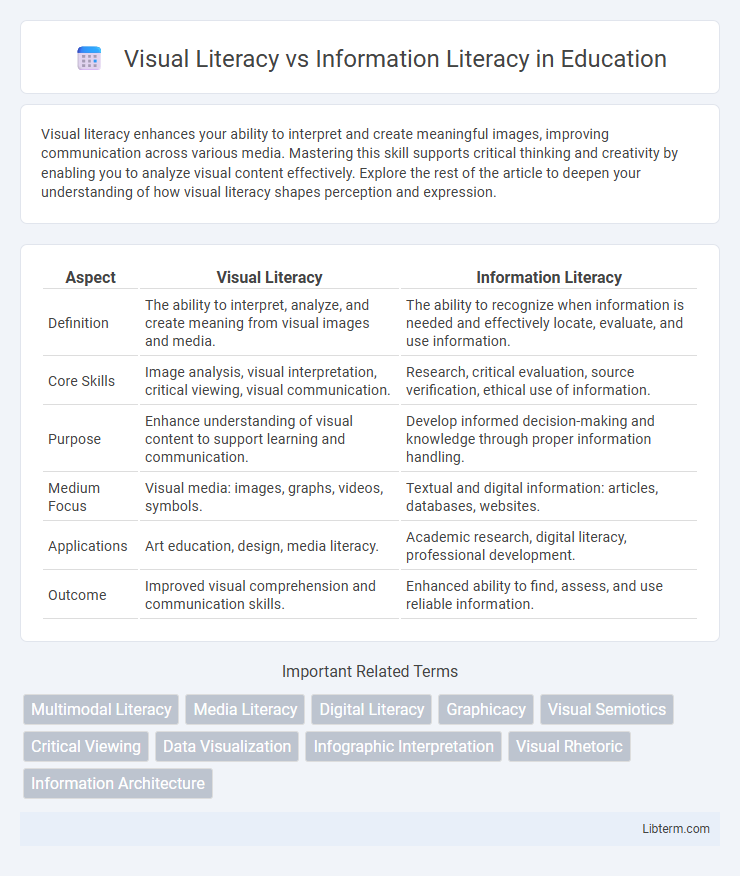Visual literacy enhances your ability to interpret and create meaningful images, improving communication across various media. Mastering this skill supports critical thinking and creativity by enabling you to analyze visual content effectively. Explore the rest of the article to deepen your understanding of how visual literacy shapes perception and expression.
Table of Comparison
| Aspect | Visual Literacy | Information Literacy |
|---|---|---|
| Definition | The ability to interpret, analyze, and create meaning from visual images and media. | The ability to recognize when information is needed and effectively locate, evaluate, and use information. |
| Core Skills | Image analysis, visual interpretation, critical viewing, visual communication. | Research, critical evaluation, source verification, ethical use of information. |
| Purpose | Enhance understanding of visual content to support learning and communication. | Develop informed decision-making and knowledge through proper information handling. |
| Medium Focus | Visual media: images, graphs, videos, symbols. | Textual and digital information: articles, databases, websites. |
| Applications | Art education, design, media literacy. | Academic research, digital literacy, professional development. |
| Outcome | Improved visual comprehension and communication skills. | Enhanced ability to find, assess, and use reliable information. |
Defining Visual Literacy: Concepts and Importance
Visual literacy involves the ability to interpret, analyze, and create visual messages through images, symbols, and visual media, enabling effective communication and comprehension in a visually-driven world. It emphasizes understanding visual elements such as composition, color, and symbolism to decode meaning and convey information accurately. Mastering visual literacy enhances critical thinking and supports information literacy by facilitating the evaluation and synthesis of visual information across diverse contexts.
Understanding Information Literacy: Key Elements
Information literacy encompasses the ability to locate, evaluate, and effectively use information from diverse sources to solve problems and make decisions. Key elements include critical thinking, understanding information sources, ethical use of data, and digital literacy skills. Mastering these components enables individuals to navigate complex information landscapes and distinguish credible content from misinformation.
Historical Evolution of Visual and Information Literacy
Visual literacy emerged in the early 20th century with roots in art education and media studies, evolving alongside technological advances in photography, film, and digital media. Information literacy gained prominence during the 1970s amidst the rise of information technology and the increasing need for critical evaluation of diverse information sources. Both literacies have transformed in response to expanding media landscapes and the growing influence of digital communication tools.
Core Skills in Visual Literacy vs Information Literacy
Core skills in visual literacy include the ability to interpret, analyze, and create visual content such as images, graphs, and videos, emphasizing understanding symbolism, visual composition, and spatial relationships. Information literacy core skills involve locating, evaluating, and using information effectively, focusing on critical thinking, source credibility assessment, and ethical use of data. Both literacies require critical analysis but differ in their primary focus: visual literacy centers on visual modes of communication, while information literacy prioritizes textual and digital information processing.
The Role of Technology in Enhancing Both Literacies
Technology plays a crucial role in enhancing visual literacy by providing dynamic tools for creating, analyzing, and interpreting images, videos, and multimedia content, which deepens users' ability to decode visual messages. In information literacy, technology facilitates efficient access to vast digital databases, advanced search engines, and data analytics platforms that empower users to critically evaluate, organize, and synthesize complex information. Integrating technological skills supports learners in navigating and merging both literacies, enabling comprehensive understanding and effective communication in digital environments.
Visual Literacy in the Digital Age
Visual literacy in the digital age encompasses the ability to interpret, analyze, and create meaning from digital images, videos, and multimedia content across various platforms. Mastery of visual literacy enables users to critically evaluate visual information, identify biases, and understand the context in which digital visuals are presented. This skill is essential for navigating the overwhelming volume of visual data encountered on social media, websites, and digital news outlets.
Information Literacy in a Data-Driven World
Information literacy in a data-driven world emphasizes the ability to critically evaluate, interpret, and utilize vast amounts of digital information to make informed decisions. Mastery in information literacy involves understanding data sources, assessing credibility, and applying ethical considerations when handling data. As organizations increasingly rely on big data and analytics, information literacy becomes essential for navigating complex datasets and transforming raw data into actionable insights.
Intersections and Differences: A Comparative Analysis
Visual literacy involves the ability to interpret, analyze, and create meaning from visual images, while information literacy focuses on locating, evaluating, and using information effectively across various formats. Both literacies intersect in critical thinking skills and the evaluation of source credibility, yet differ in their primary modes of processing--visual versus textual or data-based content. Understanding these distinctions enhances educational strategies and media consumption by integrating visual interpretation with comprehensive information assessment.
Teaching Strategies for Visual and Information Literacy
Effective teaching strategies for visual literacy emphasize analyzing and interpreting images through activities such as critical observation exercises, visual storytelling, and multimedia projects that develop students' ability to decode visual information. For information literacy, instructional approaches include teaching research strategies, evaluating source credibility, and integrating technology tools to enhance data gathering and comprehension skills. Combining these methods supports the development of comprehensive literacy skills essential for navigating complex digital environments.
Future Trends and Challenges in Literacy Education
Future trends in literacy education highlight the growing integration of visual literacy and information literacy to equip learners with the skills needed for digital and multimedia environments. Challenges include addressing the rapid evolution of technology, fostering critical thinking across diverse formats, and ensuring equitable access to digital resources. Educational frameworks increasingly emphasize interdisciplinary approaches to develop competencies that enable students to decode, analyze, and synthesize visual and informational content effectively.
Visual Literacy Infographic

 libterm.com
libterm.com